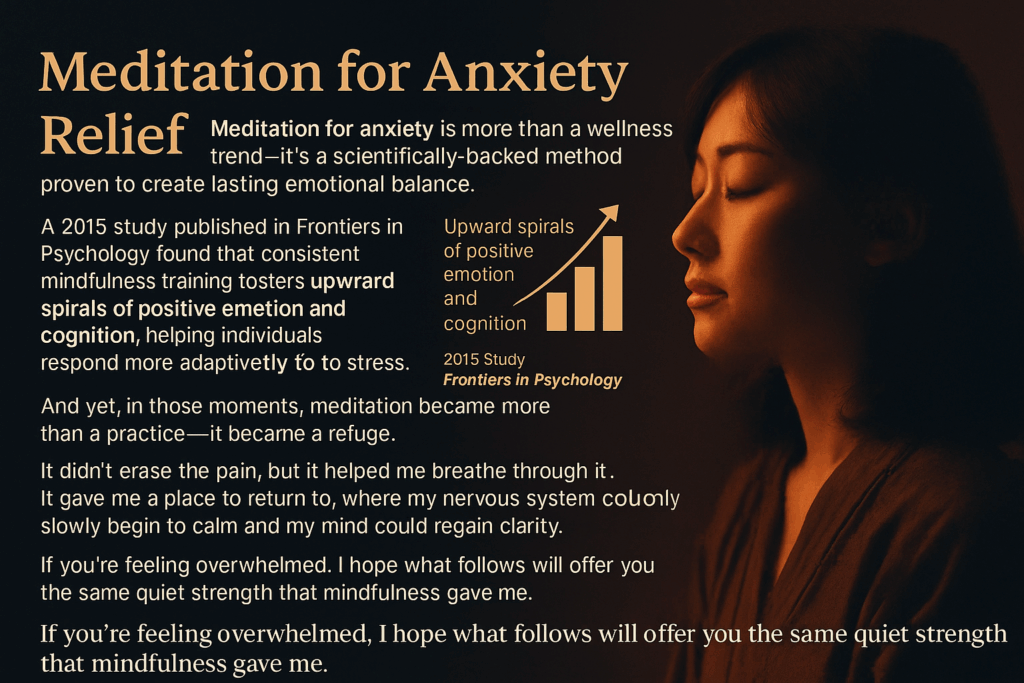
Meditation for anxiety relief is more than a wellness trend—it’s a scientifically backed method proven to create lasting emotional balance.
A 2015 study published in Frontiers in Psychology found that consistent mindfulness training fosters upward spirals of positive emotion and cognition, helping individuals respond more adaptively to stress over time.
As someone who identifies as an HSP (Highly Sensitive Person), I’ve personally felt the crushing weight of anxiety.
In the past few years, I’ve faced the passing of my beloved grandmother, my mother’s terminal illness diagnosis, and a complete shift in my workplace environment.
Each event brought a wave of uncertainty and emotional overload.
And yet, in those moments, meditation became more than a practice—it became a refuge.
It didn’t erase the pain, but it helped me breathe through it. It gave me a place to return to, where my nervous system could slowly begin to calm and my mind could regain clarity.
If you’re feeling overwhelmed, I hope what follows will offer you the same quiet strength that mindfulness gave me.

About the Author: Yosuke
Yosuke is the creator of Still Strong Blog, where he writes about meditation, mindset, and building a calm, meaningful life.
Living in Japan, he shares insights as someone with HSP, ASD tendencies, and social anxiety—hoping to inspire others on a journey toward quiet strength.
Follow me on X (formerly Twitter)
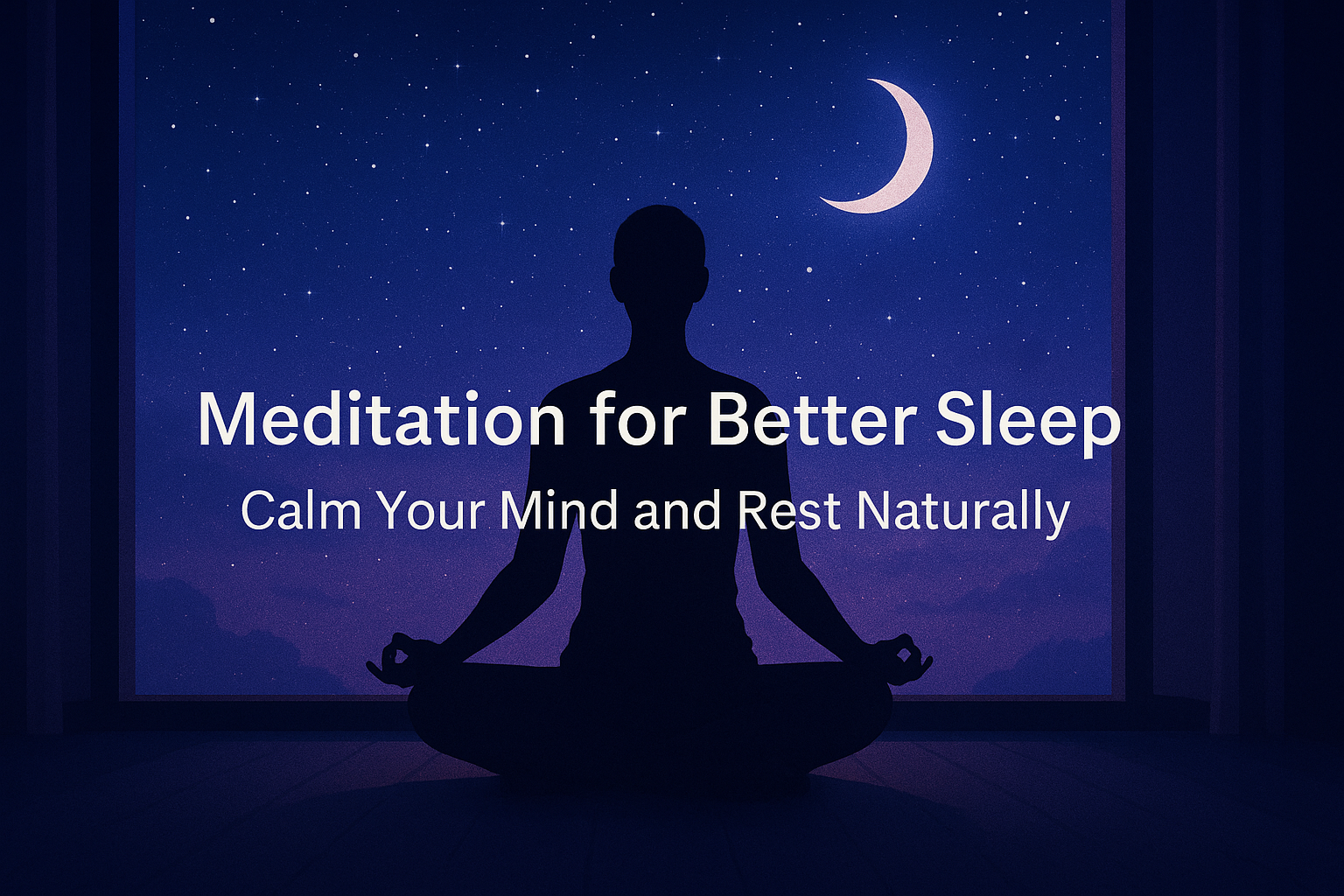
Meditation for Better Sleep: Calm Your Mind at Night
Struggling to sleep? Learn how nighttime meditation can ease your thoughts and help you rest deeply.
- 🧠 Meditation for Anxiety Relief: Why It’s a Game Changer
- 🧘♂️ Simple Meditation Techniques for Anxiety Relief
- 🗺️ Step-by-Step Guide: Start Your Meditation for Anxiety Relief Today
- 🔬 Real Results: Stories and Science Behind Meditation for Anxiety Relief
- ❓ Frequently Asked Questions about Meditation for Anxiety Relief
- 🌿 Embrace Meditation for Anxiety Relief and Calm Your Mind Every Day
🧠 Meditation for Anxiety Relief: Why It’s a Game Changer
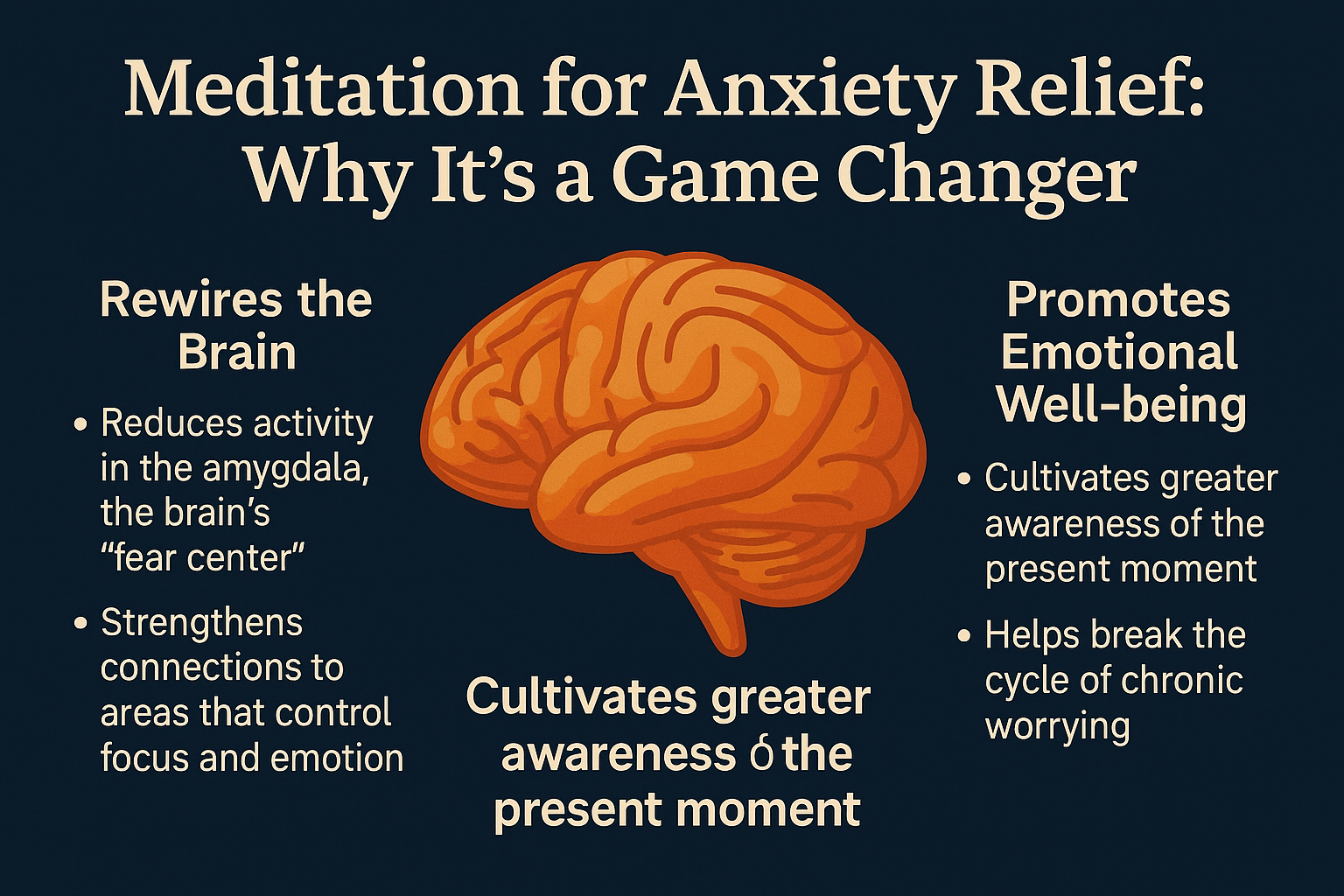
How Meditation Targets Anxiety Differently from Stress
Anxiety and stress may seem like twins, but they work differently inside the brain. While stress is usually tied to specific situations—like deadlines or arguments—anxiety is more like a lingering echo: it stays even after the trigger is gone. This makes it harder to manage through willpower alone.
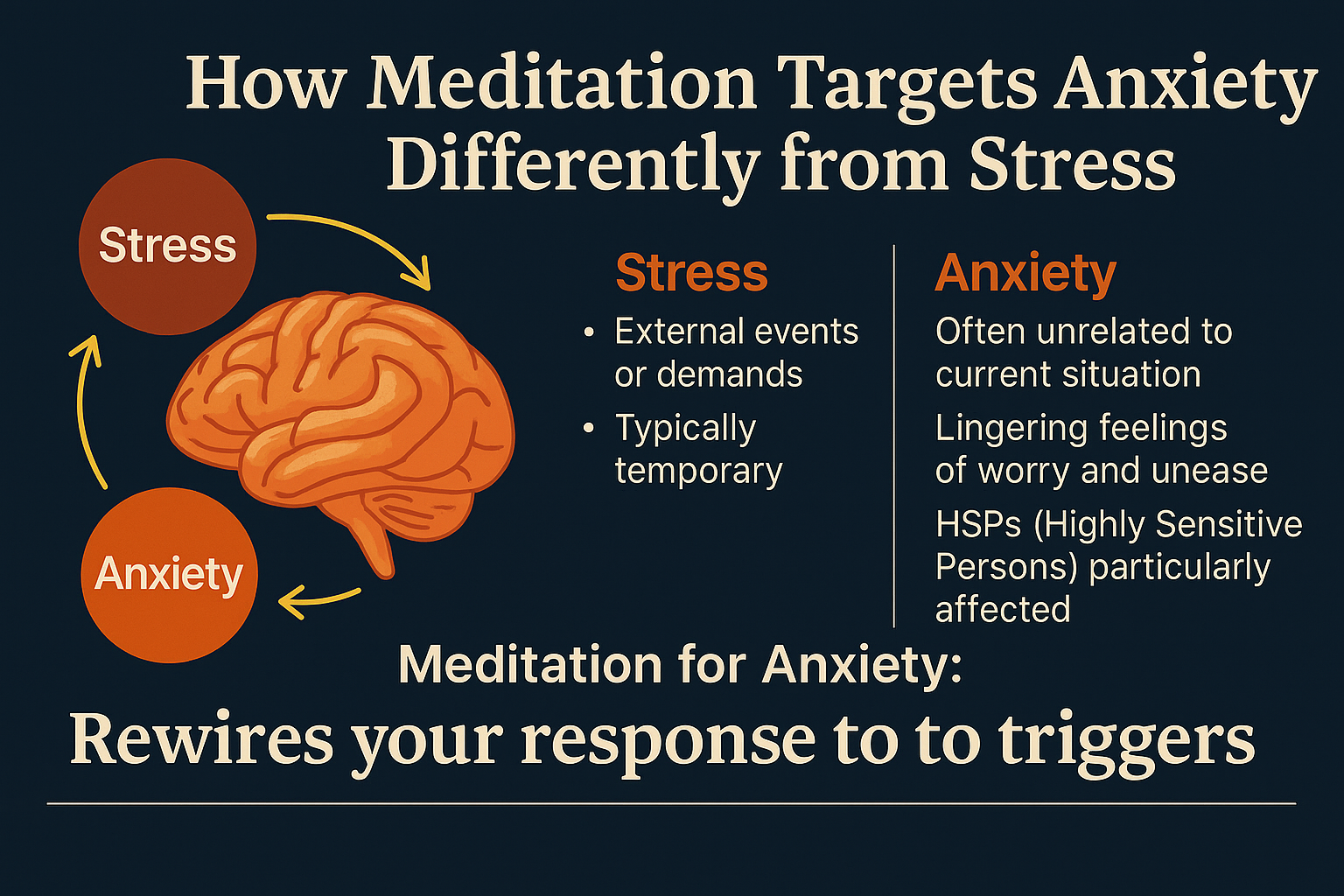
Meditation doesn’t just “relax” you—it rewires how your mind responds to those internal echoes. By focusing your attention and quieting the mental chatter, meditation interrupts the cycle of overthinking and fear-based projection that fuels anxiety.
Brain imaging studies show that regular meditation reduces the activity in the amygdala—the part of the brain responsible for fear and threat detection—while strengthening the prefrontal cortex, which governs emotional regulation. This means meditation helps your brain stop overreacting to imagined danger and start responding with clarity.
In short, meditation doesn’t just soothe the surface. It changes the system from within.
Key Benefits of Meditation for Anxiety Relief
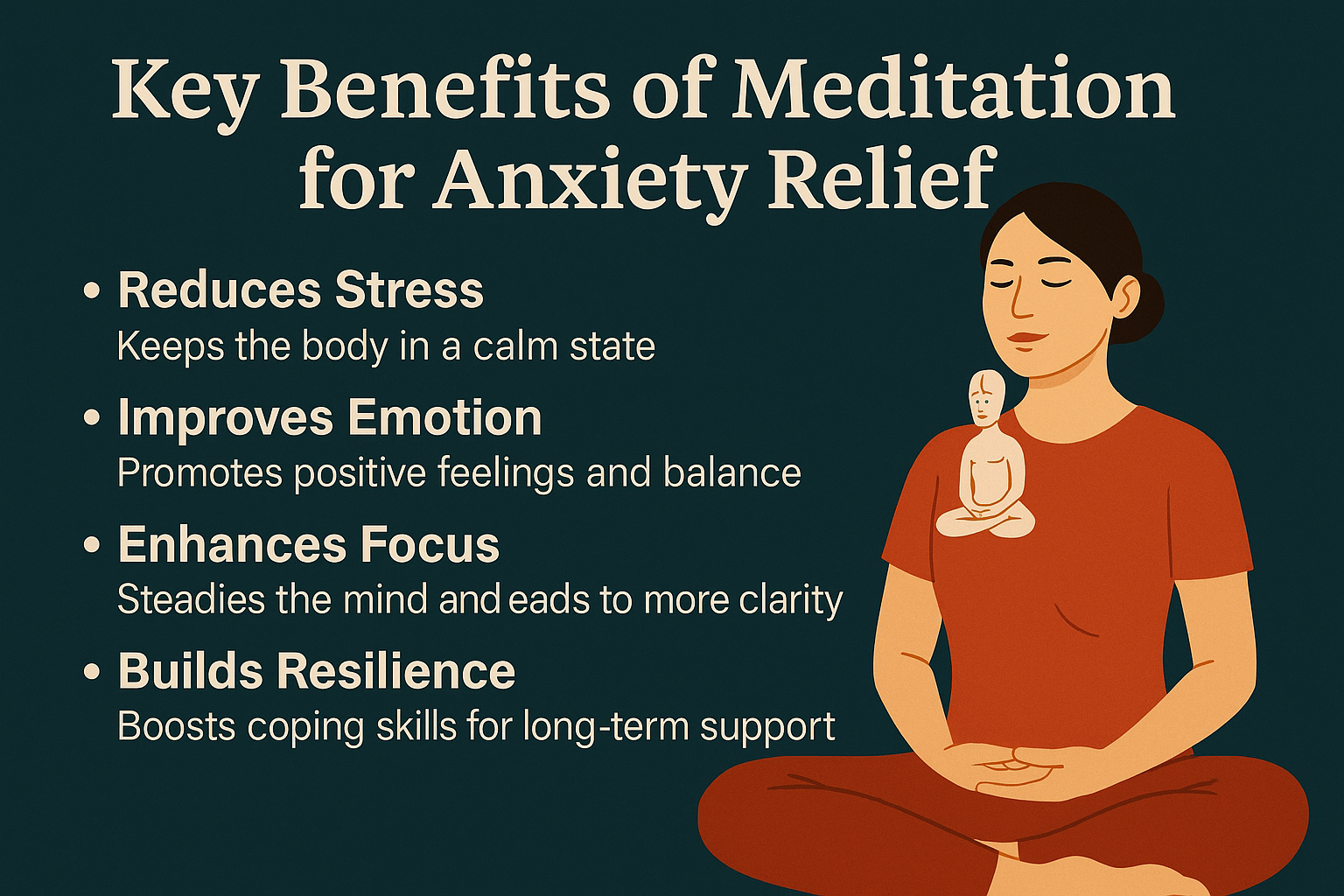
Meditation offers more than a moment of peace—it brings compounding, long-term benefits when practiced consistently. Here are some of the most powerful effects:
- Reduced rumination: Meditation trains the brain to observe thoughts rather than engage with them, breaking the loop of anxious overthinking.
- Increased emotional resilience: Over time, meditation creates what researchers call “upward spirals” of positive affect and cognition. A 2015 study from Frontiers in Psychology confirmed that mindfulness practice enhances resilience by gradually increasing daily moments of calm and positivity.
- Improved nervous system balance: Meditation activates the parasympathetic nervous system, helping you shift from “fight or flight” into “rest and digest.”
- No side effects: Unlike medication, meditation has zero physical side effects, making it ideal for those seeking natural anxiety relief.
Whether you’re dealing with daily anxiety or just need an anchor in hard times, meditation offers a powerful and accessible path to healing.
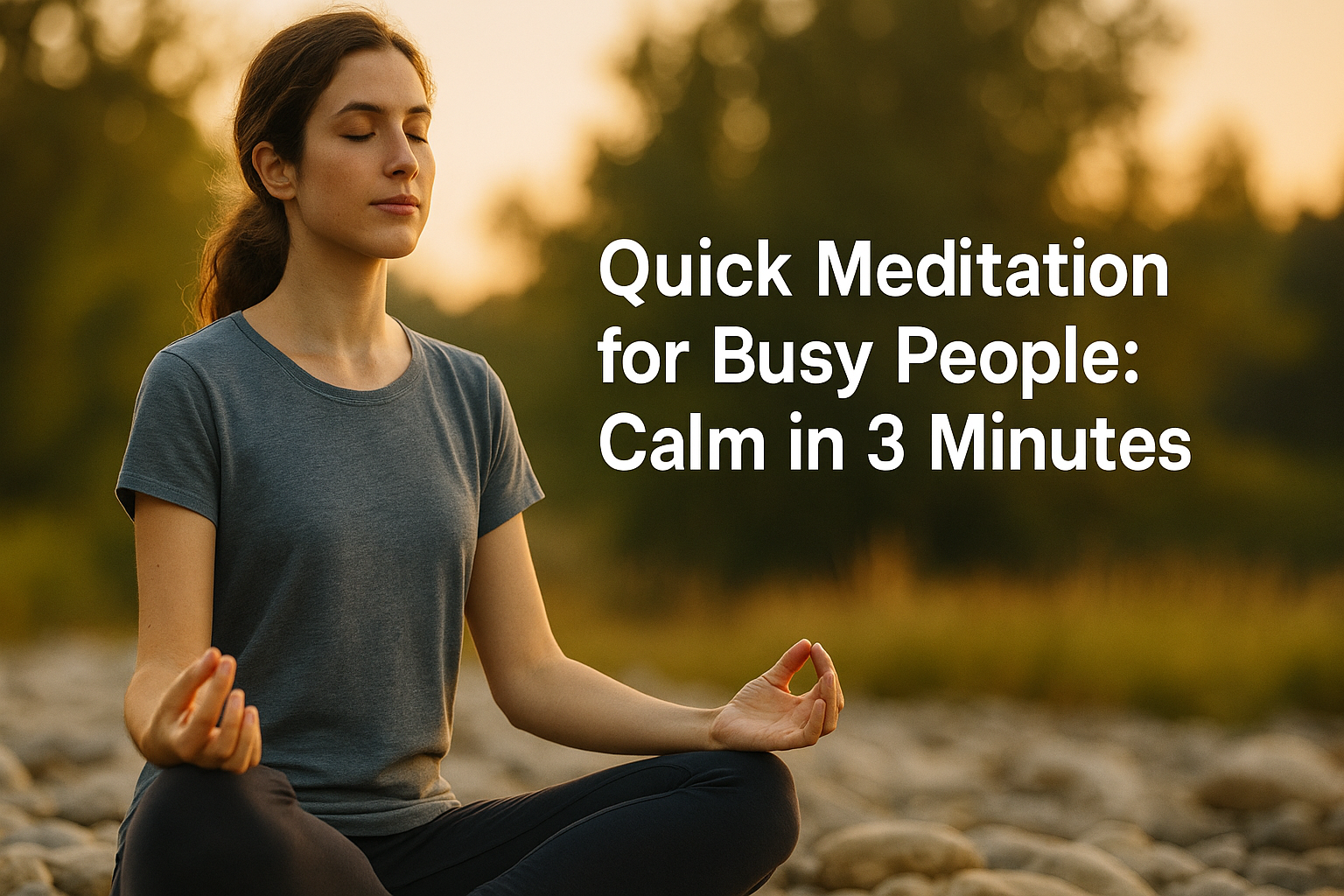
Quick Meditation for Busy People: Calm in 3 Minutes
No time? No problem. Try this 3-minute meditation that fits perfectly into any hectic schedule.
🔗 Meditative Therapies for Reducing Anxiety: A Systematic Review
This peer-reviewed study shows how different forms of meditation can significantly reduce anxiety symptoms, providing strong scientific support for using mindfulness as a treatment strategy.
Read the full article →🧘♂️ Simple Meditation Techniques for Anxiety Relief
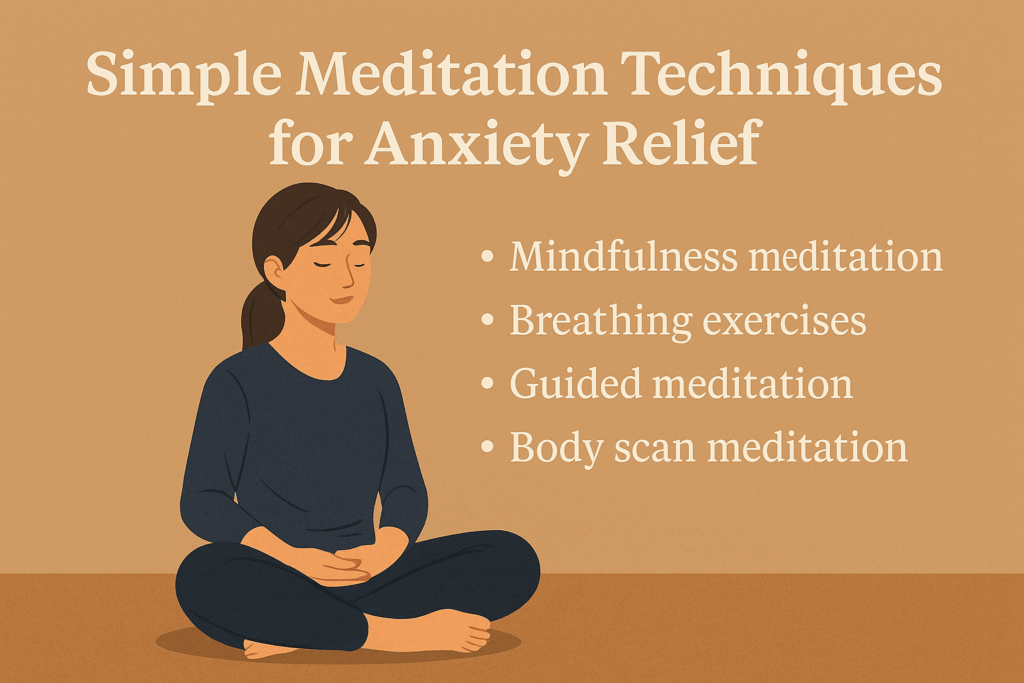
🧠 Mindfulness Meditation to Calm Your Mind
When anxiety strikes, your thoughts often feel like a runaway train—racing forward, jumping tracks, or looping back on fear.
Mindfulness meditation offers a gentle but powerful way to slow that train down, by helping you return to this moment—just as it is.
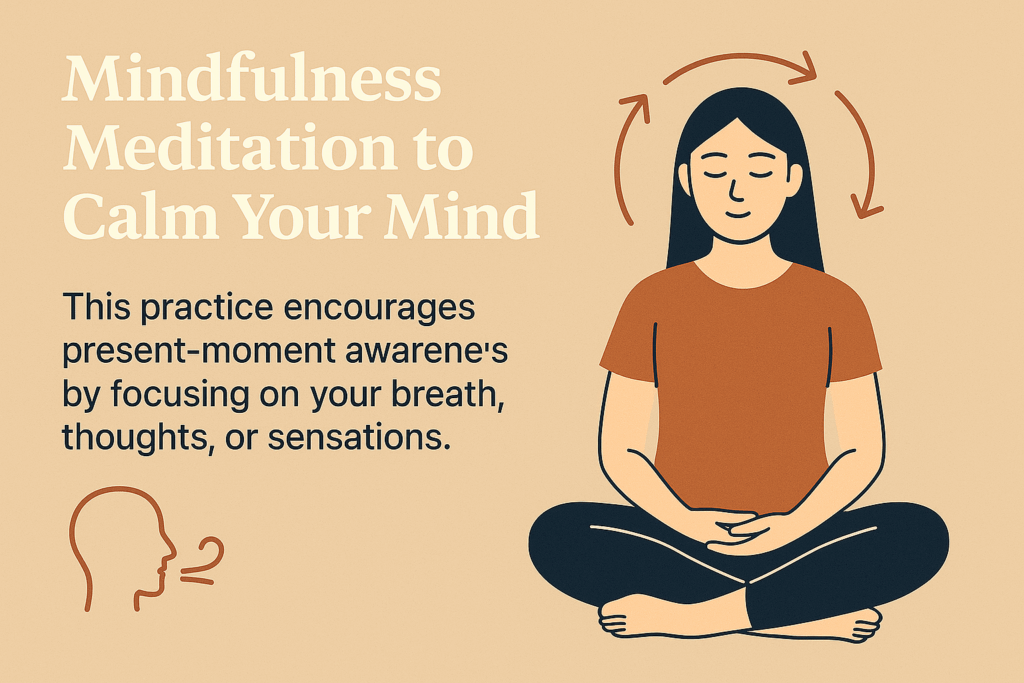
Take it from Eric, a support worker from Michigan who deals with daily emotional demands at work. He told me that after just two weeks of practicing mindfulness meditation in the evenings, he felt “a mental quiet I hadn’t experienced in years.”
I relate deeply. As someone who’s highly sensitive (HSP), I used to spiral into overthinking at night—especially after losing my grandmother, and when my mother was later diagnosed with a terminal illness. Add a workplace shift on top of that, and I often found myself unable to focus or sleep.
Mindfulness didn’t erase the pain.
But it gave me a small island of peace to return to—again and again.
Here’s how to practice it, even if you’re brand new:
- Sit in a quiet place. Eyes closed or gently lowered.
- Focus your attention on your breath.
- Thoughts will arise—that’s okay. Label them “thinking,” then gently bring your focus back.
- Do this for 3 to 5 minutes to start. No need for perfection.
Think of mindfulness like training a puppy. When the mind wanders, don’t punish it—just guide it back, kindly.
Over time, this simple practice builds the muscle of awareness and emotional steadiness. No incense, chants, or special cushions required.
🌬 Breathing Exercises for Immediate Anxiety Relief
Not all anxiety calls for a full meditation session.
Sometimes, you just need something now—something that works in a crowded room, a parked car, or even at your desk between meetings.
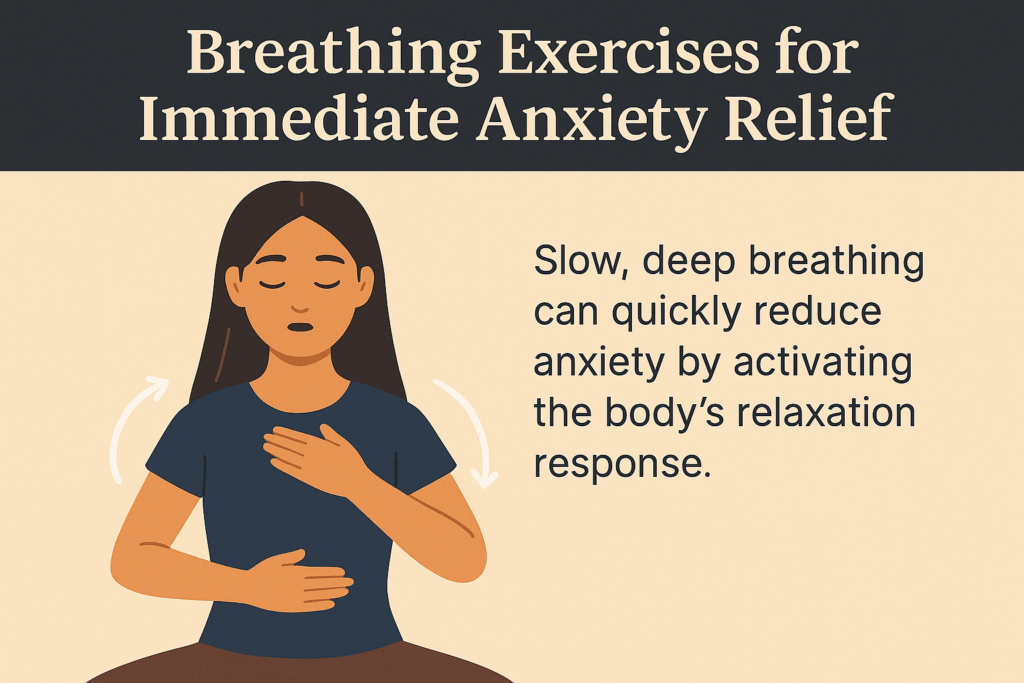
That’s where breath becomes your most portable, always-available tool.
Breathing patterns directly affect your nervous system. Fast, shallow breaths activate the sympathetic (fight-or-flight) system, while slow, deep breathing engages the parasympathetic (rest-and-digest) system—helping your mind and body relax.
I discovered this for myself during a particularly intense season: my mother had just been moved to a care facility, and my job situation had shifted dramatically. Some days I couldn’t find time to sit and meditate—but I could breathe.
Here’s the technique that helped me most:
🌫 The 4-2-6 Breathing Technique
Inhale for 4 seconds
Hold for 2 seconds
Exhale slowly for 6 seconds (preferably through the mouth with a soft sigh)
Repeat for 6–10 cycles
This rhythm creates a sense of internal spaciousness.
Even after just 2–3 minutes, it slows your heart rate, reduces cortisol, and sends a message to your brain: you are safe.
Eric, too, found this helpful before emotionally draining meetings.
He told me, “It sounds silly, but counting my breath grounded me more than anything else that day.”
You don’t need a quiet room or a meditation app to do this.
Just your lungs—and your attention.
Try it the next time anxiety whispers in your chest.
Breathe, count, and return.
🎧 Guided Meditation Practices for Beginners
If you’re new to meditation—or if your anxiety makes it hard to focus alone—guided meditation can be a lifesaver.
It removes the pressure to “do it right” and offers a soothing voice to anchor you when your thoughts begin to spiral.
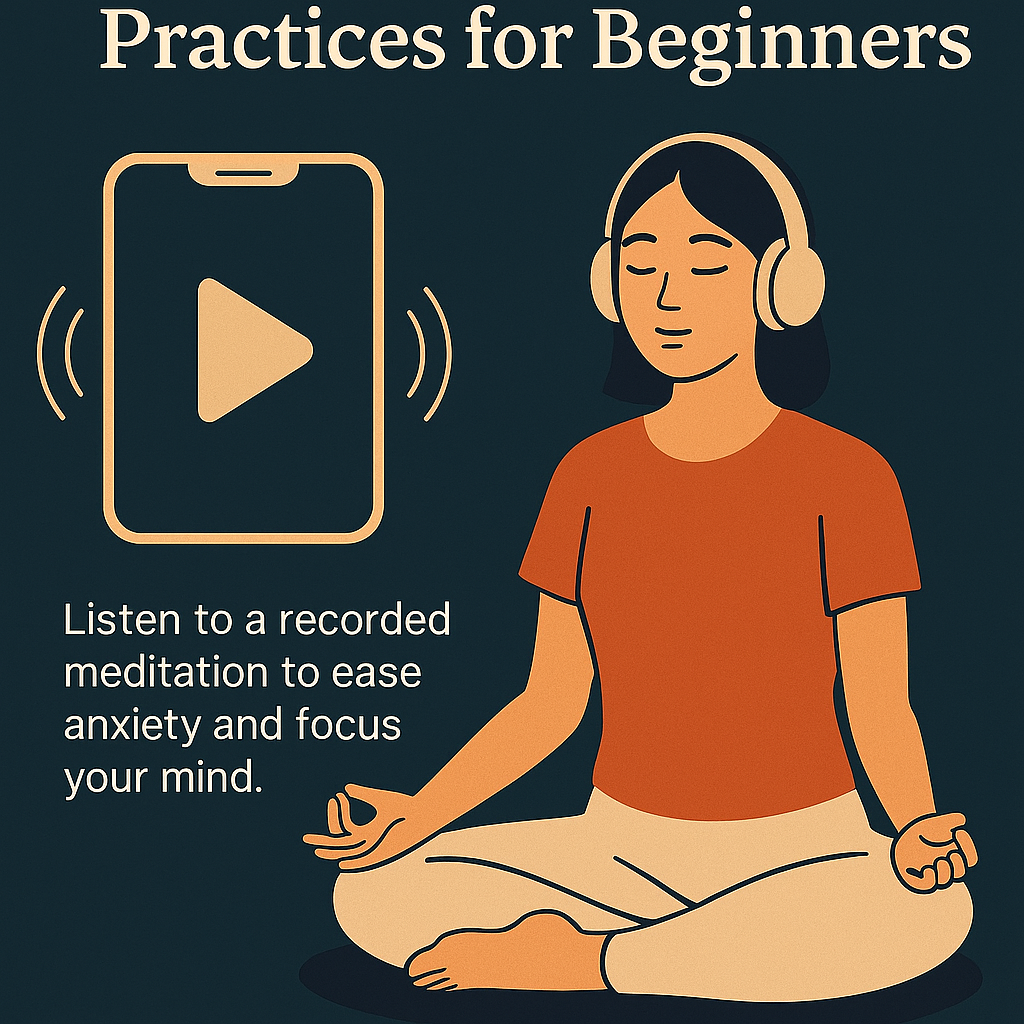
When I was first trying to navigate overwhelming stress (my mother’s illness, work instability, and a growing sense of emotional fatigue), I struggled to meditate in silence. My mind would drift back to worry or grief within seconds. But then I found comfort in guided meditations—like being led by the hand through a fog I couldn’t see through on my own.
Eric, too, mentioned that guided meditations helped him stay consistent.
He uses the Headspace app on his commute home and often listens to short “Breathe” sessions before bed. “It gives my mind something to follow,” he said. “I just have to show up and press play.”
Here are some great tools to get started:
🛠 Recommended Guided Meditation Apps (Beginner-Friendly)
- Headspace – Friendly, science-backed, with dedicated tracks for anxiety, sleep, and panic moments.
- Insight Timer – Free, wide-ranging content, including meditations under 5 minutes.
- Calm – Excellent audio quality, with “Emergency Calm” sessions for moments of high stress.
- YouTube – Search for “10-minute guided meditation for anxiety”—there are thousands of free options.
Tips for making guided meditation work:
- Use headphones for immersive focus
- Choose short tracks (3–10 minutes) to start
- Don’t aim for “perfect focus”—just notice, breathe, and return
Remember: Meditation isn’t about stopping thoughts. It’s about changing how you relate to them.
Guided practice lowers the barrier to entry and increases the chances that you’ll return tomorrow.
And the next day.
And the next—until calm becomes your new habit.
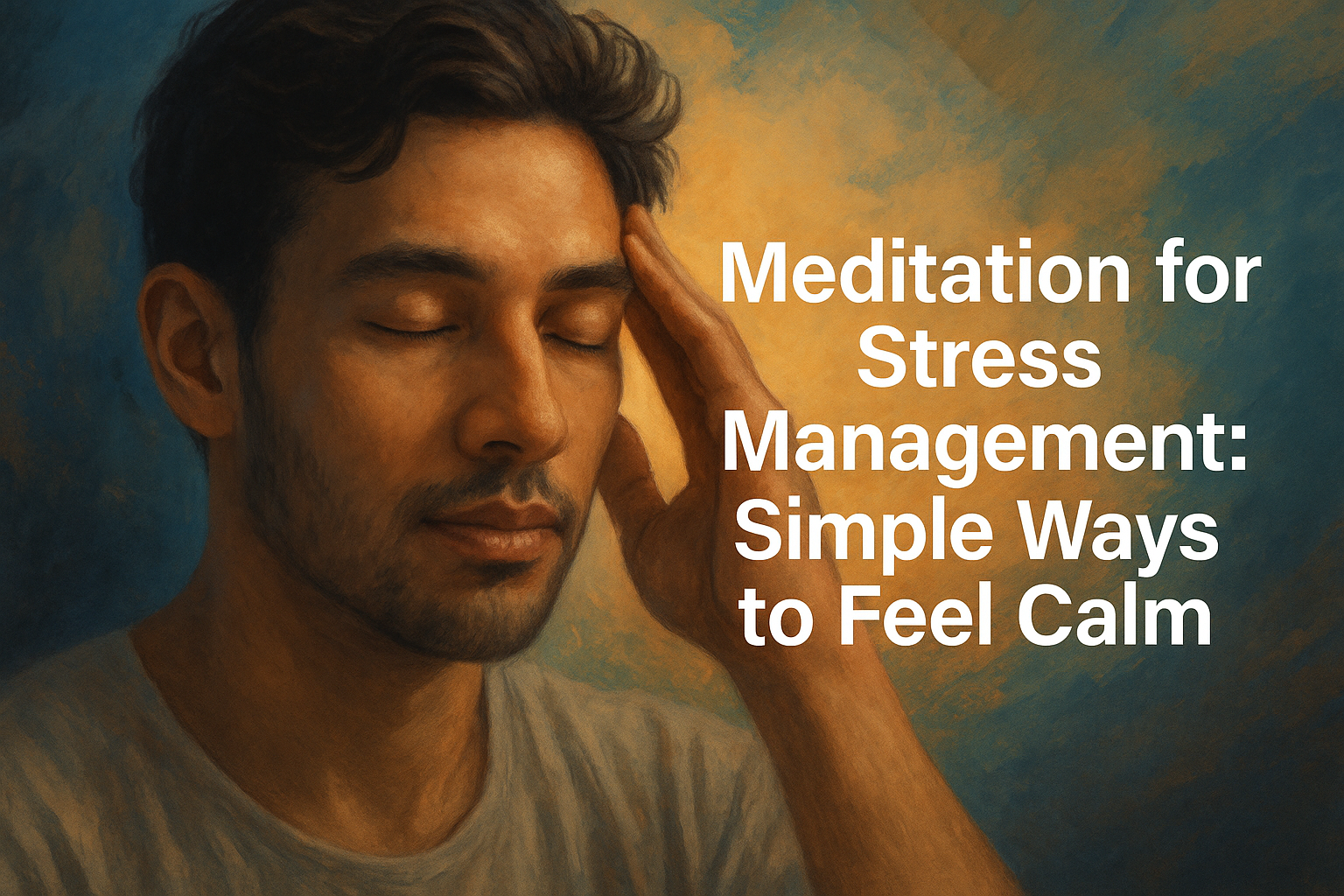
Meditation for Stress Management: Simple Ways to Feel Calm
Feeling overwhelmed? These quick meditation tips will help you stay calm and grounded during your busiest days.
🔗 Meditation: A simple, fast way to reduce stress – Mayo Clinic
Mayo Clinic explains practical meditation techniques that anyone can use to reduce stress and anxiety—ideal for beginners looking for actionable steps.
Explore the guide →🗺️ Step-by-Step Guide: Start Your Meditation for Anxiety Relief Today
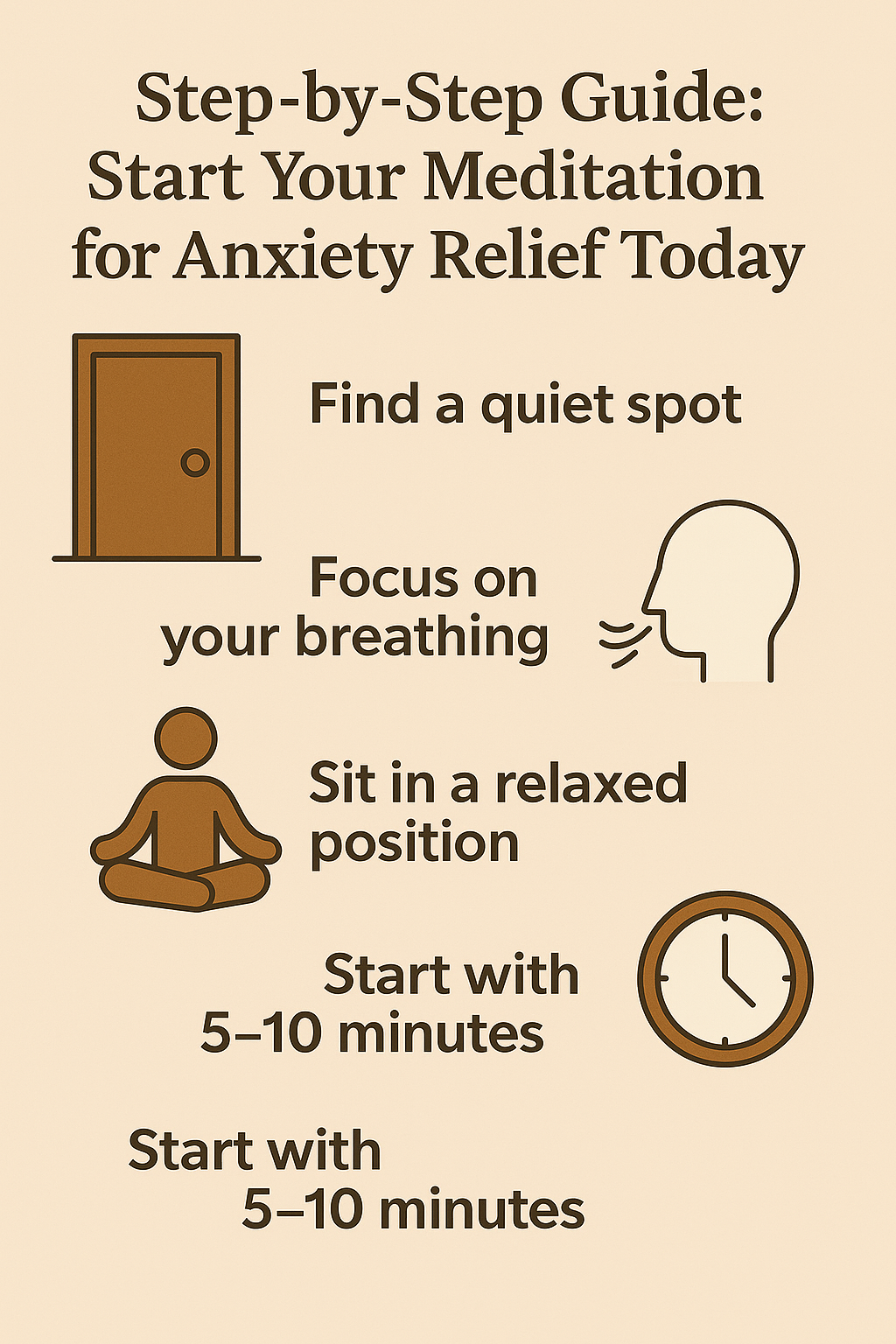
🛋️ Setting Up a Calming Space
Before you begin, set yourself up for success.
You don’t need a fancy room or incense sticks—just a space that feels safe, simple, and distraction-free.
After my workplace changed, I felt emotionally scattered most evenings. I started by simply sitting in a quiet corner of my room with the light dimmed and a small plant nearby. That corner became my “anchor”—a space where I could arrive just as I was, without needing to fix anything.
What you need:
- A comfortable chair or cushion
- A quiet space (even just a few feet of floor)
- Optional: a candle, soft light, or calming scent
- Your phone on airplane mode or “Do Not Disturb”
Tip: If you live with others, communicate that this is your quiet time—even 5 minutes can make a difference.
Creating a familiar setup will train your brain to associate that space with calm.
⏳ Easy Daily Routine for Anxiety Relief
Consistency beats intensity.
Here’s a simple routine that both I and Eric have found sustainable—even on difficult days:
| 🕒 Time of Day | 🧘 What to Do | 💡 Why It Helps |
|---|---|---|
| Morning (3–5 min) | 4-2-6 breathing or short body scan | Sets a grounded tone before the day begins |
| Midday (3 min) | One-minute pause + mindful breath | Resets your nervous system during work stress |
| Evening (5–10 min) | Guided meditation or quiet sitting | Clears mental clutter before sleep |
No need to do it all.
Pick one moment in your day and show up consistently. Over time, meditation becomes less of a task and more of a return home.
🔁 Tips for Staying Consistent with Your Practice
Building a habit takes patience—but a few tricks can help:
- Pair it with an existing habit (e.g., after brushing teeth or before coffee)
- Use a simple tracker (calendar or habit app) to keep momentum
- Set low-pressure goals: “2 minutes” is still success
- Forgive breaks—missing a day doesn’t mean you’ve failed
I used to get discouraged if I missed three days in a row. But then I reminded myself: it’s not about streaks—it’s about starting again, and again, and again.
The goal isn’t to become a perfect meditator.
The goal is to keep coming back—to your breath, your body, your self.
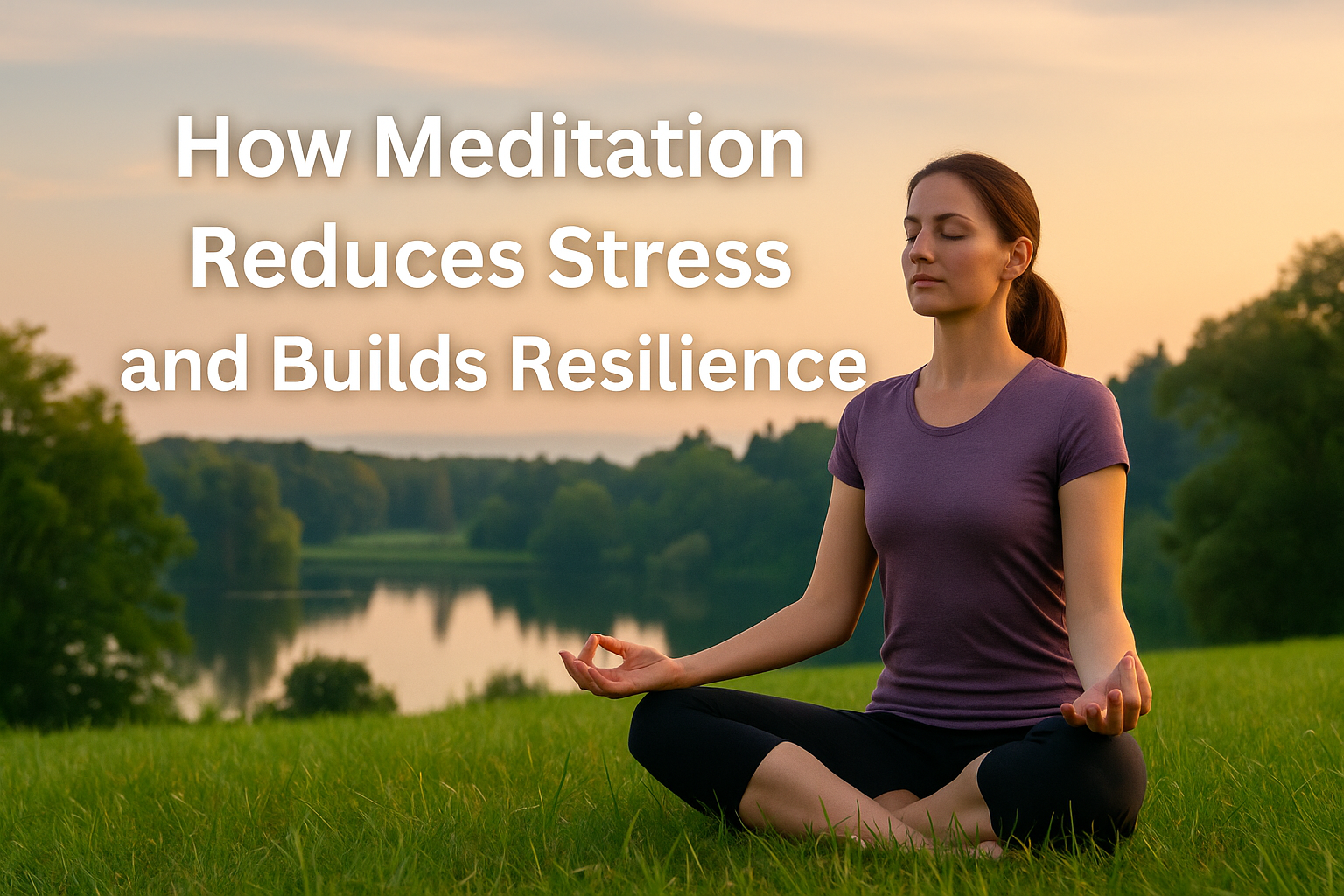
How Meditation Reduces Stress and Builds Resilience
Learn how meditation not only calms you down, but actually rewires your mind to bounce back from tough times.
🔗 Mindfulness meditation: A research-proven way to reduce stress – APA
The American Psychological Association outlines how mindfulness meditation works and provides research-backed steps for integrating it into your daily routine.
See APA’s recommendation →🔬 Real Results: Stories and Science Behind Meditation for Anxiety Relief
👥 Personal Experiences Overcoming Anxiety with Meditation
Behind every study, there’s a real person searching for relief.
People like Eric, who works in a high-empathy, high-stress job supporting individuals with disabilities. He once told me, “There were days I’d go home with this invisible weight on my chest. I didn’t even realize I was holding my breath until I started meditating.”
After just three weeks of nightly mindfulness, he noticed he wasn’t getting overwhelmed by minor setbacks anymore. “I still had bad days,” he said, “but they stopped becoming bad weeks.”
I’ve felt that shift myself.
There was a time when I couldn’t make it through the day without my thoughts spiraling—especially after my grandmother passed away, and my mother received her diagnosis. In those moments, meditation wasn’t about escaping pain—it was about staying present without being consumed by it.
And we’re not alone.
- On Mindful.org, one writer shared how panic attacks ruled her life until she committed to daily practice. Over time, the attacks lost their grip, and she began to feel safer in her own body again.
- Headspace compiled real user stories—people who battled anxiety, insomnia, even grief—with simple guided meditations. What they gained wasn’t perfection, but a lifeline.
🧪 Scientific Evidence Supporting Meditation’s Effect on Anxiety
These personal stories align with what science has made increasingly clear:
A 2015 study in Frontiers in Psychology found that consistent mindfulness practice helps create “upward spirals” of positive affect and cognition.
This means that instead of being dragged downward by anxiety, you begin to develop small moments of clarity, calm, and resilience—which compound over time. (Garland et al., 2015)
Functional MRI studies have also shown:
- Decreased amygdala activity after 8 weeks of meditation
- Increased gray matter in areas related to emotional regulation
- Improved heart rate variability (HRV) and lowered cortisol levels
These aren’t just temporary changes—they reflect real neurological and physiological rewiring that supports long-term emotional balance.
Meditation isn’t just a “nice-to-have.”
It’s a tool, backed by science, that empowers us to respond to anxiety with compassion instead of panic.
🔗 Meditation effective in treating anxiety, depression – Johns Hopkins
Johns Hopkins University reviewed dozens of clinical studies and confirmed that meditation is as effective as antidepressants for many people with anxiety and depression.
Read the Hopkins study →❓ Frequently Asked Questions about Meditation for Anxiety Relief
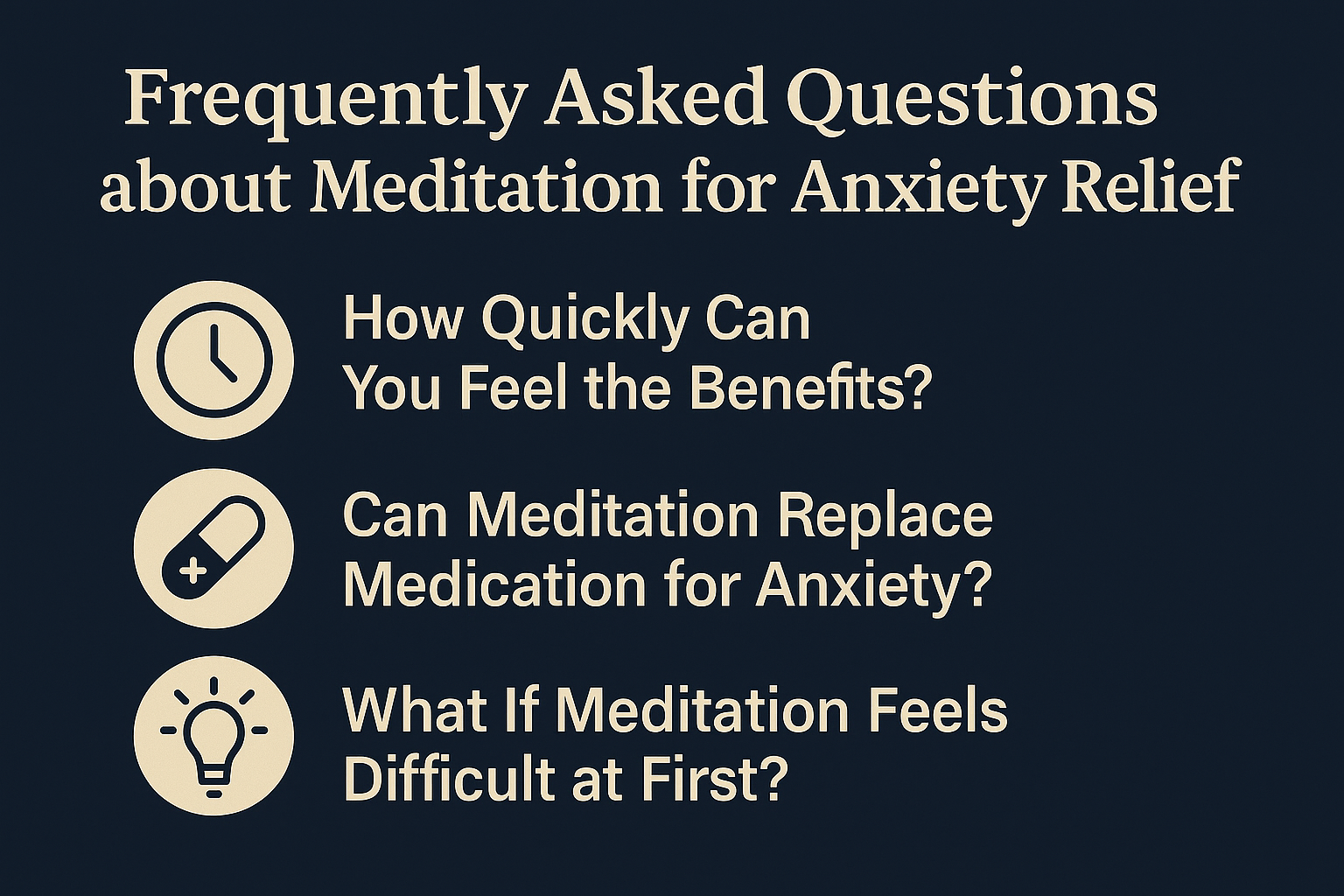
⏱️ How Quickly Can You Feel the Benefits?
Many people wonder, “Does this actually work—and how soon?”
The truth is: some effects are immediate, while others build over time.
For instance, breathing-based meditation (like the 4-2-6 method) can trigger a parasympathetic response within just one minute, slowing your heart rate and calming physical symptoms of anxiety.
Longer-term, studies like the one by Garland et al. (2015) show that consistent mindfulness practice—just 10–20 minutes a day for 6 to 8 weeks—can significantly reduce anxious rumination and boost emotional resilience.
Take the story from Mindful.org:
The author described how she didn’t notice huge shifts at first—but after a few weeks of practice, she suddenly realized she was handling stressful situations with more grace. The panic attacks that once ruled her life started to lose their grip.
🌱 Small changes compound.
Trust the process, even if the results feel subtle at first.
💊 Can Meditation Replace Medication for Anxiety?
This is a common question—and a sensitive one.
For some, yes—meditation can eventually reduce or even replace the need for medication, especially in cases of mild to moderate anxiety.
But this should always be done in consultation with a healthcare provider.
Meditation isn’t a quick fix—it’s a long-term self-regulation skill that works best when integrated into a holistic approach.
According to user stories from Headspace, several individuals reported lowering their dosage or moving away from anxiety meds altogether—but all emphasized gradual transition and professional support.
🧘♀️ Think of meditation not as a replacement, but as a foundation.
One that strengthens your baseline and creates space for other treatments to work more effectively.
🌀 What If Meditation Feels Difficult at First?
That’s perfectly normal—and actually expected.
Anxious minds are naturally restless. Sitting still with them can feel like putting your hand into a beehive. But the key is this: meditation isn’t about “emptying your mind.” It’s about changing your relationship with your thoughts.
I remember struggling with this myself. At the height of my stress—after my grandmother passed, while juggling a new job and my mother’s illness—trying to meditate felt like pouring water into a storm.
But with the help of short guided sessions (often just 5 minutes), I slowly built tolerance. What once felt impossible began to feel… spacious.
Here are some tips if you’re finding it hard to stick with it:
- Start with 1–3 minutes—set a timer, and don’t overcommit
- Use guided tracks with calming voices and ambient music
- Try moving meditation (like walking or gentle yoga)
- Be kind to yourself: there’s no such thing as failing meditation
“Difficult” just means you’re doing the work.
Keep showing up. That’s where the change happens.
🔗 12 Science-Based Benefits of Meditation – Healthline
From anxiety reduction to improved sleep, Healthline summarizes the most well-researched benefits of meditation and how they impact everyday mental health.
Explore the list →🌿 Embrace Meditation for Anxiety Relief and Calm Your Mind Every Day
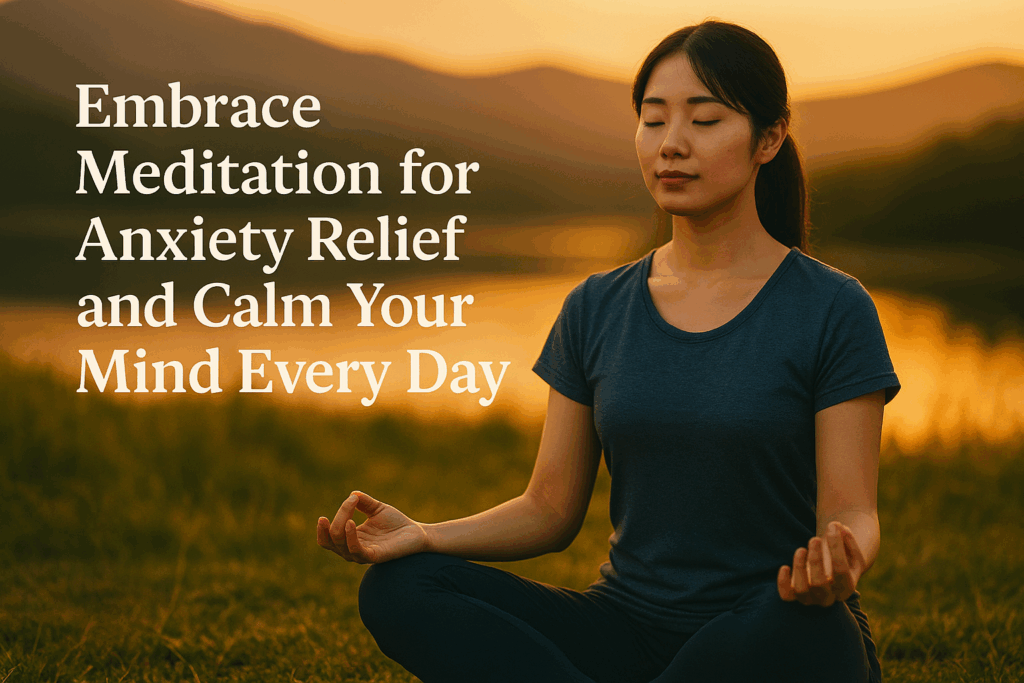
Anxiety thrives in chaos—when your thoughts race, your breath shortens, and everything feels just a little too loud.
Meditation doesn’t promise to silence the world.
But it offers you a place inside yourself that stays quiet, even when everything outside feels unsteady.
If you’re like Eric, managing the emotional weight of others while barely keeping your own balance…
Or like me, navigating loss, illness, and change as a highly sensitive person in a noisy world…
Then you already know how heavy life can feel.
But you don’t have to carry all of it without rest.
With just a few minutes a day, meditation gives you space.
To breathe.
To feel.
To soften.
You don’t need to be perfect. You don’t even need to be calm to begin.
You only need to begin.
Start with one breath.
One minute.
One moment of coming back to yourself.
And over time, that moment becomes a practice.
That practice becomes a habit.
And that habit becomes a lifeline.
🙏 Thank you for reading.
If this article helped you—even a little—I invite you to bookmark it, share it with someone you care about, or return to it the next time anxiety shows up.
You’re not alone. And you don’t have to fight it all in your head.
Breathe. You’re home.
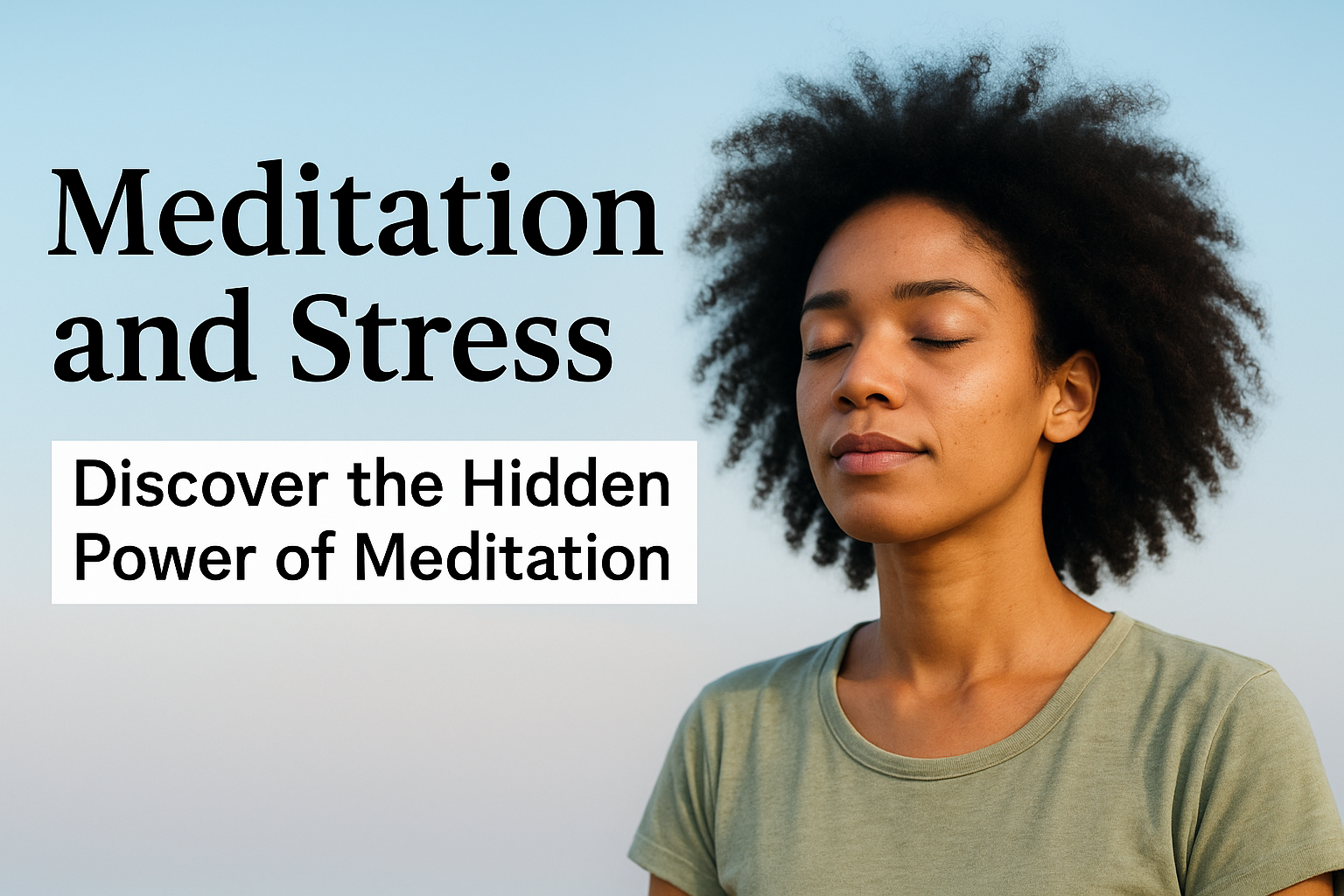
Meditation and Stress: The Hidden Link to Inner Strength
Discover how meditation strengthens your mental resilience and helps you deal with stress from the inside out.
🔗 Meditation as Effective as Lexapro for Anxiety – NPR
NPR highlights a groundbreaking 2022 study showing that meditation may be just as effective as anxiety medication like Lexapro—with fewer side effects.
Listen or read the full story →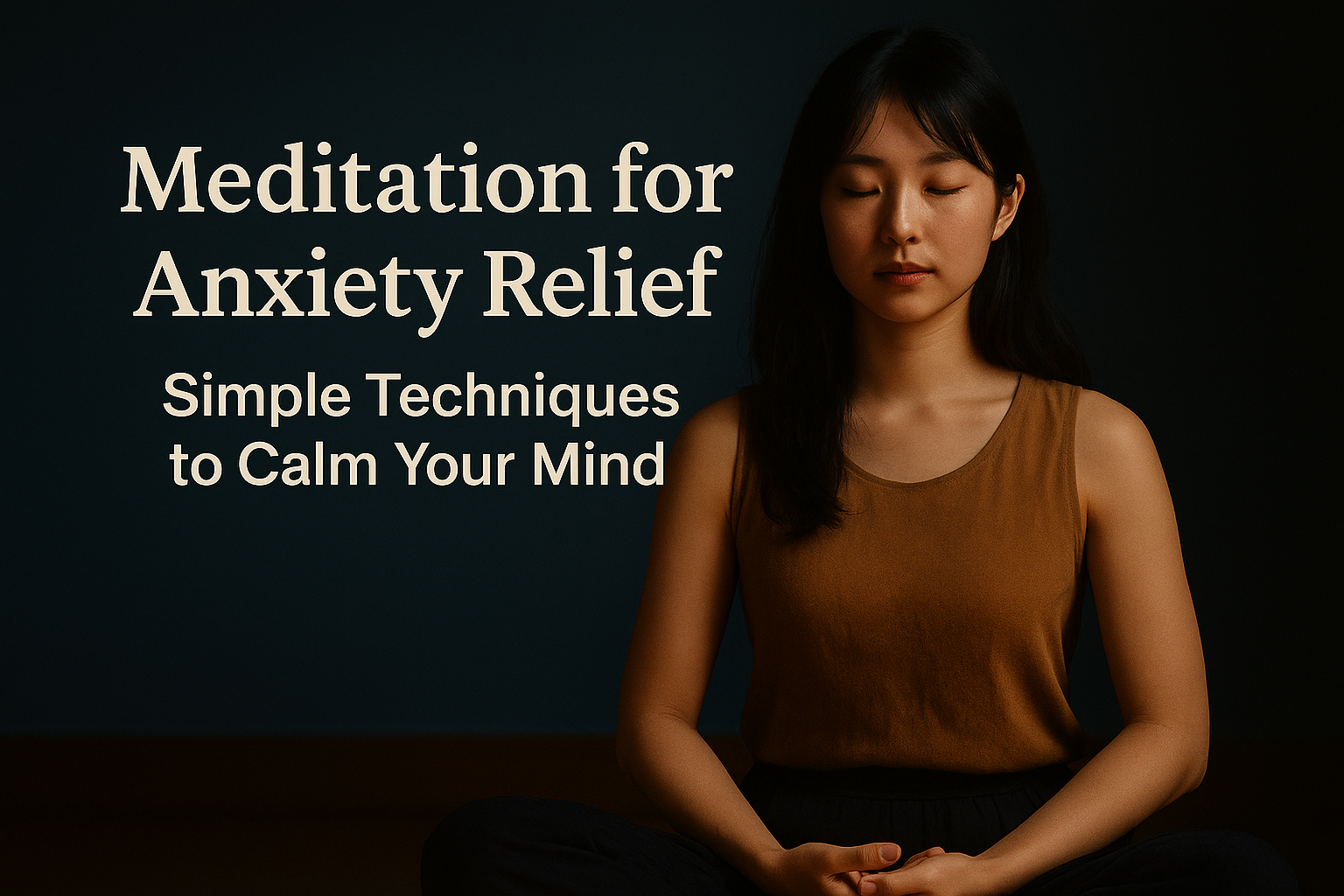

Comments